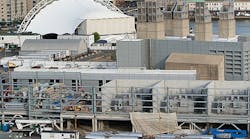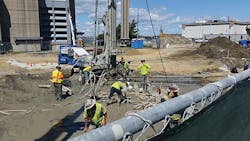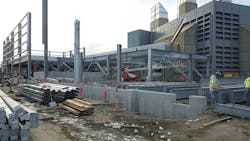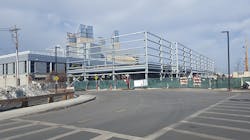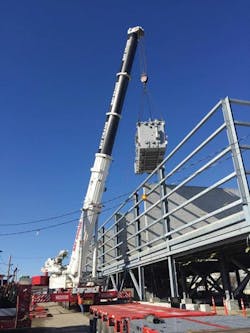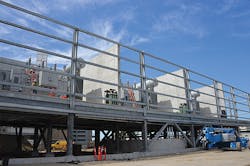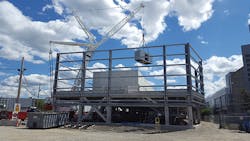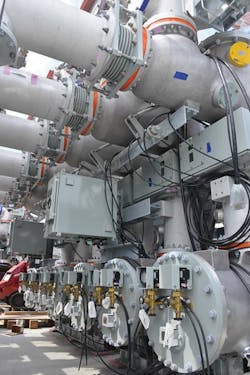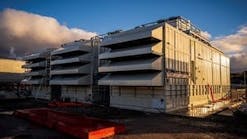These are certainly heady times for Boston, Massachusetts, U.S. Unprecedented development of the South Boston Waterfront has spawned a vast array of new and exciting places for Bostonians to work, live, visit and play. This dramatic growth did not go unnoticed by Eversource Energy. The utility quickly recognized electrical demands of existing, newly constructed and planned facilities would change electrical loads dramatically in the region. Electrical studies indicated the existing K Street substation in South Boston would reach its firm capacity potentially by the next decade or sooner, with the only direct path from K Street to this area being an existing underwater cable tunnel.
Eversource took action. After completing purpose and necessity studies, the utility decided to construct a new substation to meet the growing electrical needs of the developing region. The new Station 99 would relieve heavy loading conditions at K Street and provide a much-needed infusion of distribution capacity into the area.
Integrated Project Organization
The implementation would not be simple. Numerous permitting, land acquisition and regulatory approvals would be required. Unique first-of-its-kind design features also would be necessary. In addition, the design-procure-build effort would need to be fast-tracked to meet the ultimate goal of providing increased reliability and new services to the region by the end of 2016.
Individually, any one of these challenges was considered formidable to overcome; collectively, they seemed nearly insurmountable. To address the challenge, Eversource engaged an outside transmission and distribution engineering, procurement and construction (EPC) firm to join the effort.
After a careful interview and selection process, Eversource chose Burns & McDonnell to provide overall project management; permitting support; conceptual and detail-level station engineering and design; major station equipment procurement support and vendor design coordination; transmission and distribution street routing plans and profiles; station and remote end controls and protection designs; project controls; estimating; cost and schedule integration; construction contract administration; construction oversight management; quality assurance; testing and commissioning support; and outage planning.
Following the establishment of an integrated project organization, with a work breakdown structure and organizational roles and responsibilities clearly defined, the hard work of planning and execution commenced in earnest.
Unique Design Features
After forming the team, tireless hours of work progressed seamlessly to ensure each and every facet of the project was planned and executed carefully. The utmost attention to safety, quality, budget and schedule were the benchmarks of team efficiencies. Also noteworthy, Station 99 was one of three similar projects Eversource had undertaken concurrently. As a result, lessons learned from Station 99 were quickly integrated into the other projects.
Station 99 was designed for a firm capacity of 150 MVA with the following features:
• Four bays of 115-kV gas-insulated switchgear (GIS), manufactured by Mitsubishi Electric, will be arranged in an isolated-phase, breaker-and-a-half configuration (12 115-kV independent pole-tripping breakers with dual trip coils). The station will interconnect to existing 115-kV lines in the area.
• Three 117/15-kV, 90-MVA transformers manufactured by HICO will be enclosed for isolation purposes by three-sided cast-in-place reinforced concrete fire walls and fire dampers on the air-intake louvers. In addition, a high-pressure water mist fire-suppression system manufactured by Marioff will protect the transformers further.
• Four sections of 15-kV shelter aisle metal-clad distribution switchgear, manufactured by AZZ, will support eight feeders per bus section of switchgear, with 32 feeders.
• Four 15-kV capacitor banks, manufactured by Powell Industries, will provide 9.6 MVAR.
In addition, a control enclosure with alternating-current and direct-current power will provide protective relaying equipment for the 12 115-kV breakers, four 115-kV lines, three 117/15-kV transformers and two 115-kV end buses, manufactured by KVA Electrical Maintenance and Construction. The protection and control design consists of two independent systems, designated as system P1 and system P2, which will be separated physically and electrically. All the electrical equipment is equipped with plugs to connect the external control wiring. Control cables, precut to length and equipped with plugs on both ends, will be fabricated off-site while the equipment is being set in place. This will eliminate the need to terminate control conductors individually in the field.
Communication will be achieved through a new communications node consisting of two redundant fiber-optic paths. Two JMUX cabinets and two sets of transfer trip equipment will be installed between Station 99 and the remote ends of the lines.
Initially, four (ultimately five) 115-kV incoming underground transmission supply lines consisting of an 8.625-inch (219-mm) outer diameter with 0.125-inch (3.175-mm) wall PRITEC-coated welded steel high-pressure, fluid-filled (HPFF) pipe-type cables will interconnect the new Station 99 to the existing transmission ring between the Mystic and K Street stations. The cable installation and splicing will consist of four sections of 3500-kcmil aluminum, 115-kV pipe-type cable. There will be 2750 circuit-ft (838 circuit-m) of four extensions to existing lines.
There will be four three-phase joints in one new and one existing manhole. In addition, there will be 12 single-phase GIS terminations within Station 99, six of which will be for the incoming lines.
Distribution feeder getaways installed in the new duct bank and manholes from Station 99 will interconnect with the existing duct banks to accommodate 32 feeders. Initially, the cable for 24 line-circuit cutovers will consist of nearly 36,000 ft (10,973 m) of 3-conductor 1000-kcmil triplexed cable.
The distribution system in the area has both solidly and restively grounded sections. Two of the three transformers will serve three-phase loads and will be equipped with grounding resistors and bypass switches. The third transformer will be grounded solidly and will serve single line-to-ground load. In the event of an outage of this single transformer, the single line-to-ground load will be backed up by one of the resistor-grounded transformers. The resistor bypass switches will close automatically when the transformers need to back up the transformer serving single-phase load and signal ground overcurrent relays to change settings to adapt to the change in system grounding.
Siting and Design Challenges
The project required overcoming siting and design challenges. The first challenge was locating a parcel large enough to accommodate the new station in an area of unprecedented growth, where available real estate was difficult to come by. The utility owned two adjacent parcels that, together, were deemed large enough to accommodate the new station. The prior owners — the Massachusetts Turnpike Authority and the City of Boston Economic Development Industrial Corp. along with the Boston Redevelopment Authority — retained certain right-of-way restrictions and covenants, such as no build zones, which affected the design of foundations and various underground infrastructure locations.
Because of the new station’s proximity to the Boston Harbor, a first-of-its-kind design feature was incorporated to protect against an increasing risk of coastal storm surges. The station equipment is situated on a 15-ft-high, 25,000-sq-ft (4.6-m-high, 2323-sq-m) elevated platform, with room for vehicle access below at ground level. The platform elevation is in comparison to a reference point at grade on the site that would be 10.9 ft (3.3 m) above mean sea level, so the substation platform would be approximately 25.9 ft (7.9 m) above mean sea level, which is above predicted flood levels.
Since Station 99 is within the South Boston Waterfrontarea , Eversource worked with the Boston Redevelopment Authority to ensure the station would be aesthetically pleasing, complete with a perimeter screen wall consisting of architectural precast concrete panels and stainless-steel perforated metal panels and louvers. The team engaged specialty architect Utile Design to work with the Boston Redevelopment Authority on this design element.
Additionally, the potential for a future vertical expansion drove the structural design of the station. Historical survey and geotechnical explorations performed by GEI Consultants determined the land was previously used as a World War II U.S. naval base, consisting of old building foundations, granite seawalls, wharves and dry docks covered by historic fill. GEI recommended the elevated platform be supported by small-diameter drilled piles (micropiles) drilled into rock, approximately 80 ft (24 m) below the surface.
After assessing the dead load of the elevated platform and equipment, the structural design resulted in a total of 496 micropiles, with an 82.5-ton capacity, supporting cast-in-place reinforced concrete pile caps and grade beams as the foundation for the structural steel and 12-inch-thick (305-mm-thick) reinforced-concrete platform. The micropile installation work encountered numerous underground obstructions, slowing drilling operations and resulting in frequent drilling equipment failures. The work continued under difficult conditions. Specialty drilling equipment was brought in to overcome the most difficult underground obstructions.
When drilling was complete, the cast-in-place reinforced concrete and structural steel erection work moved ahead quickly, with the added necessity of winter weather concrete protective measures being taken. Finally, in spring 2016, the platform was ready for electrical equipment deliveries to begin.
All Systems Go
Currently, the GIS and transformers are under assembly, the control house is in fabrication, and the switchgear and capacitor banks are complete and ready for delivery. The transmission pipelines are under construction, as are the distribution duct banks. Burns & McDonnell is managing all contractors’ installation activities and orchestrating schedule sequencing of a multitude of contractors, subcontractors and material providers.
Burns & McDonnell also has provided transmission outage plans and schedules, which the Eversource long-term outage planning group is currently studying for submission to ISO-New England for approval.
All systems are a go for an early October 2016 cutover of the first transmission line, which will electrify the 115-kV GIS. This will enable the testing and commissioning of the station to begin, in support of the originally conceived end-of-year in-service date.
After completion of the project, Eversource will have achieved its goal of increasing the availability and reliability of electric service in the rapidly developing South Boston Waterfront district. Use of early system planning and successful integrated project organization enabled all participants to come together to construct and complete this complex project successfully.
John M. Zicko is the director of Massachusetts substation engineering at Eversource Energy. He is a registered professional engineer with 32 years of experience in both office and field engineering aspects of electrical substations and systems. He holds a BSEE degree from Northeastern University and a master’s degree from Lesley College. He joined Eversource in 1984, where he worked as a field engineer testing, commissioning and troubleshooting substation and generating station equipment prior to joining substation engineering. He has led the engineering effort on a variety of multidisciplined projects and followed field construction.
David Petersile is a senior project manager for Burns & McDonnell’s construction/design-build division. He has a BSCE degree from Rutgers University, is a certified project management professional and a certified professional constructor. With more than 35 years of experience, he has served as a project manager, resident engineer and owner’s representative for a variety of heavy civil, commercial building, mechanical, electrical power generation and distribution, process plant and utility projects.
